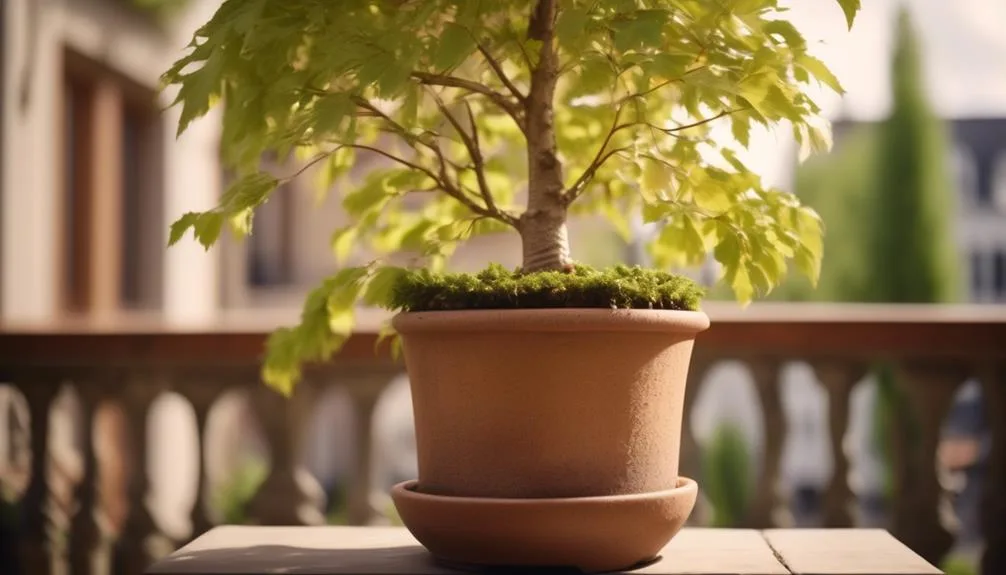Thinking about growing a beech tree in a pot? It's possible, but there are important things to consider.
From choosing the right tree variety to picking the best pot and providing proper care, there's a lot to explore.
Let's dive into the world of growing beech trees in pots and unravel the unique horticultural journey it offers.
Suitable Beech Tree Varieties for Pots
Wondering which beech tree varieties are best suited for pot cultivation?
When it comes to growing beech trees in pots, it's essential to choose the right variety. The European beech (Fagus sylvatica) and Japanese beech (Fagus crenata) are popular choices for container cultivation. These varieties have compact root systems, making them well-suited for growing in pots. Additionally, they're relatively slow-growing, which means they can thrive in the confined space of a container for an extended period.
When it comes to soil requirements, a well-draining potting mix with a slightly acidic pH is ideal for beech trees.
Regular pruning techniques are also crucial to maintain the desired shape and size of the tree while growing in a pot.
Choosing the Right Pot for Beech Trees
When selecting the right pot for your beech tree, it's crucial to consider the compact root system of varieties like the European beech and Japanese beech, which are well-suited for container cultivation due to their slow growth and adaptable nature.
Choose a pot that provides ample room for the roots to spread out. The pot should be at least 2-3 times the size of the tree's root ball, allowing for future growth.
Proper drainage is essential to prevent waterlogging, so ensure the pot has drainage holes at the bottom.
When it comes to soil, use a well-draining mix specifically formulated for trees.
As for watering, establish a regular schedule, allowing the soil to dry out slightly between waterings.
Planting and Caring for Beech Trees in Pots
To successfully plant and care for beech trees in pots, it's important to understand the specific requirements for soil, sunlight, and watering that will help your tree thrive in a container environment.
When planting, ensure the pot has good drainage and use a well-draining, loamy soil mix.
Place the pot in a location where the beech tree will receive partial sunlight to full shade, depending on the specific variety.
Water the tree consistently, allowing the soil to dry slightly between waterings to prevent root rot.
As for fertilization, use a balanced slow-release fertilizer in the spring.
When it comes to pruning techniques, remove dead or damaged branches and shape the tree as desired.
It's essential to establish a watering schedule and maintain proper soil composition to ensure the health and vitality of your potted beech tree.
Potential Challenges of Growing Beech Trees in Pots
You may encounter several challenges when growing beech trees in pots, such as managing root growth and providing adequate space for the tree to thrive. Here are some potential challenges to consider:
- Root Confinement: Limited space in the container can lead to root-bound issues, affecting the tree's overall health.
- Water and Nutrient Management: Ensuring proper watering and nutrient levels can be challenging in containers, as the soil may dry out more quickly.
- Container Size: Selecting an appropriate container size is crucial to accommodate the tree's growth and prevent root constriction.
- Temperature Regulation: Potted beech trees may be more susceptible to temperature fluctuations, requiring extra care during extreme weather conditions.
- Transplanting Stress: When transplanting or repotting, the tree may experience stress, impacting its growth and development.
Successfully growing beech trees in pots requires careful consideration of these challenges.
Tips for Success With Beech Trees in Pots
Confronting the challenges of growing beech trees in pots can be rewarding with the right strategies and care, leading to healthy and thriving trees that enhance your living space. To ensure success, proper pruning techniques and soil composition are essential. When it comes to pruning, regular maintenance is key. Trim back any dead or damaged branches to encourage new growth and maintain the tree's shape. Additionally, consider root pruning every few years to prevent the tree from becoming root-bound. As for soil composition, a well-draining mix is crucial. A combination of peat moss, pine bark, and perlite can provide the necessary aeration and moisture retention. Remember to repot your beech tree every few years to refresh the soil and provide ample space for root growth.
| Pruning Techniques | Soil Composition |
|---|---|
| Regular maintenance is essential | Well-draining soil mix |
| Trim dead or damaged branches | Peat moss, pine bark, and perlite |
| Consider root pruning | Ensure aeration and moisture retention |
| Repot every few years | Provide ample space for root growth |
Conclusion
Incorporating beech trees into small spaces is achievable with the right variety, pot, and attentive care.
By selecting a suitable variety, using a sufficiently large pot, and ensuring consistent watering and fertilizing, you can savor the elegance of beech trees.
Keep an eye out for potential challenges and adjust your care accordingly.
With these considerations, successfully nurturing beech trees in pots is within reach, allowing you to appreciate their graceful allure in limited spaces.

My interest in trees started when I first saw the giant sequoias in Yosemite.
I was a teenager then, and I remember thinking, “I need to learn more about this.”
That moment stuck with me.
A few years later, I went on to study forestry at Michigan Tech.
Since graduating, I’ve worked in a mix of hands-on tree care and community education.
I’ve spent over ten years helping people understand how to plant, maintain, and protect the trees in their neighborhoods.
I don’t see trees as just part of the landscape.
They are living things that make a real difference in our daily lives.
